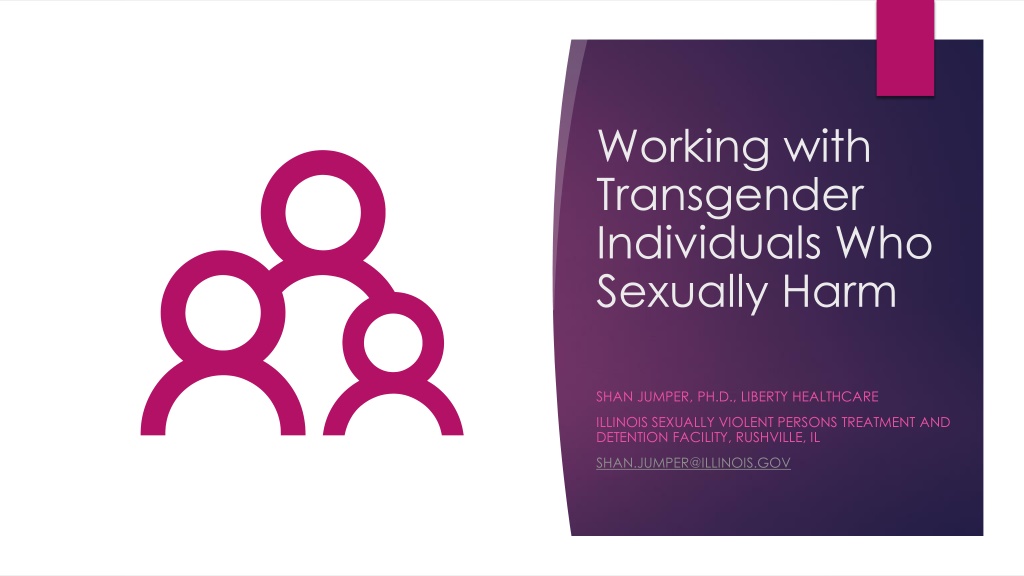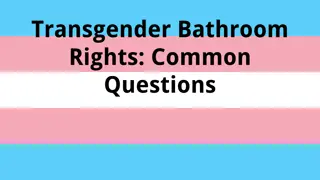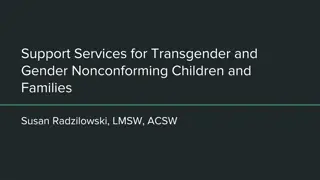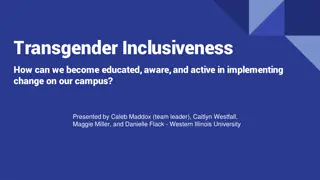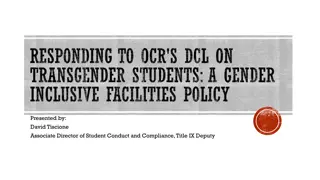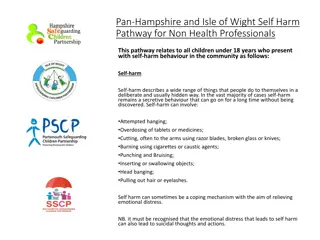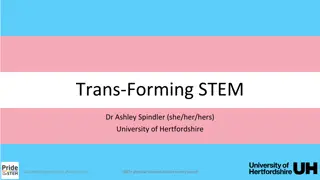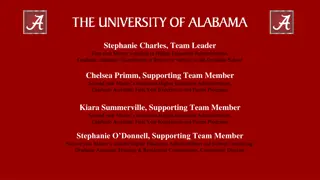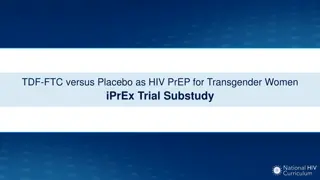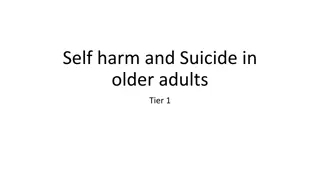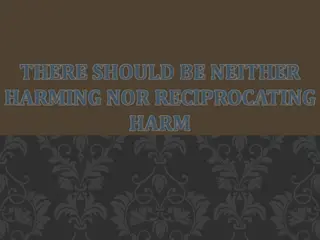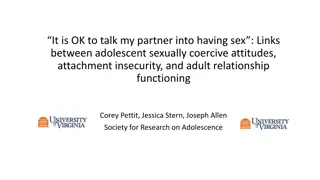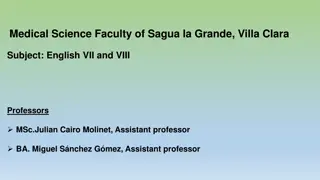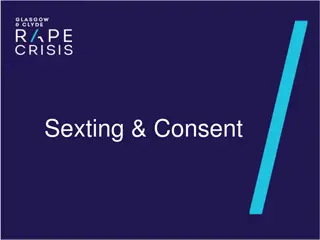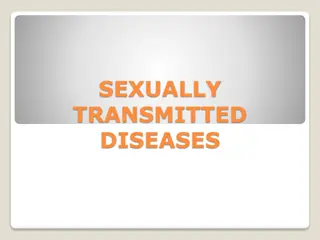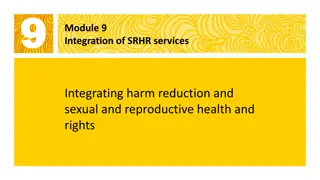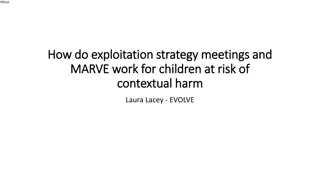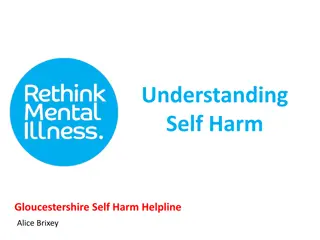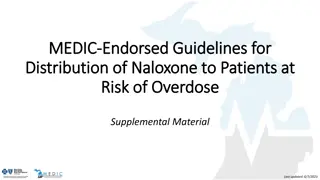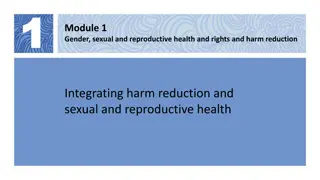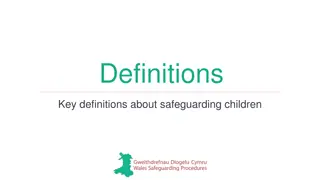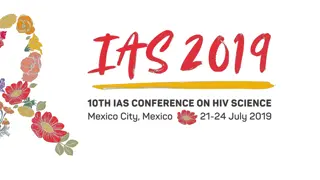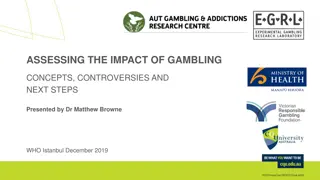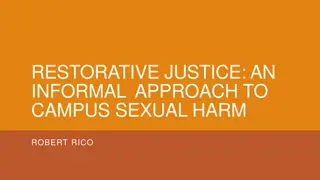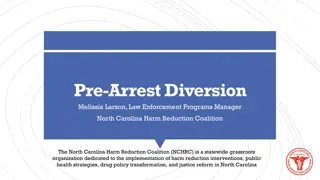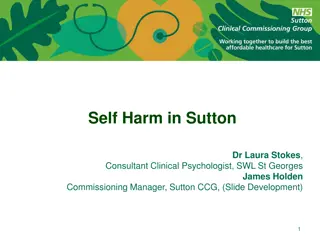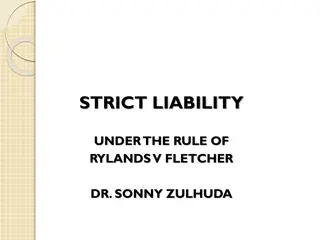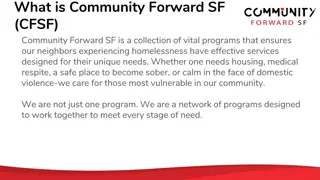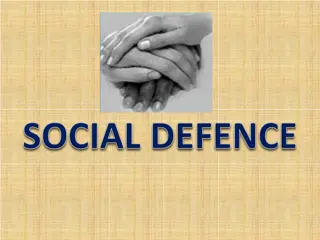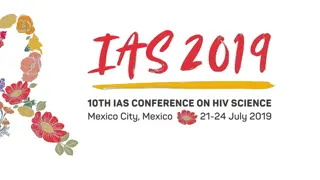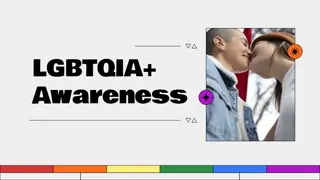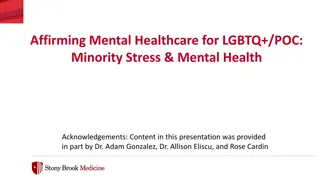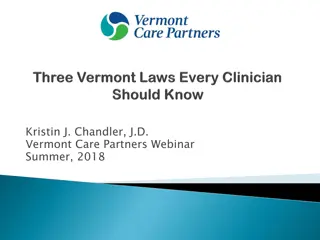Understanding and Working with Transgender Individuals Who Sexually Harm
Explore the complexities of addressing sexual harm in transgender populations, learning objectives include understanding transgender experiences, treatment standards, and DSM-V diagnostic criteria for Gender Identity Disorder. Delve into issues like sexual harm, gender dysphoria, and personal biases for effective intervention.
Download Presentation

Please find below an Image/Link to download the presentation.
The content on the website is provided AS IS for your information and personal use only. It may not be sold, licensed, or shared on other websites without obtaining consent from the author. Download presentation by click this link. If you encounter any issues during the download, it is possible that the publisher has removed the file from their server.
E N D
Presentation Transcript
Working with Transgender Individuals Who Sexually Harm SHAN JUMPER, PH.D., LIBERTY HEALTHCARE ILLINOIS SEXUALLY VIOLENT PERSONS TREATMENT AND DETENTION FACILITY, RUSHVILLE, IL SHAN.JUMPER@ILLINOIS.GOV
Caveats I m not an expert there s a lot to learn about this complicated issue. Virtually nothing in the sex offending literature addressing this issue. My experience has been exclusively with MtF trans.(trans women) Terminology sensitivity
Learning objectives This workshop is designed to help you: 1. Summarize the institutional transgender experience. 2. Utilize the appropriate standards and progression for the management of transgender SVPs and for the treatment of those with Gender Dysphoria. 3. Analyze the DSM V diagnostic criteria for Gender Identity Disorder. 4. Discuss treatment of dynamic risk of sexual harm for individuals experiencing gender dysphoria.
Transgender people who sexually harm - basics Understand both issues well: Sexual harm Transgender identity Identity vs. orientation vs expression Be ready for self-reflection Personal biases, counter-transference, etc, as well as those of your colleagues Gender Dysphoria and the medicalization of transgender individuals vs. informed consent model.
Terms Cisgender: A person whose gender identity matches with the sex they were assigned at birth Gender affirming hormone treatment GAHT). I prefer this term over the more commonly used Hormone Replacement Therapy Gender fluid: Refers to an identity under the nonbinary and transgender umbrellas. Genderfluid individuals have different gender identities at different times. A genderfluid individual s gender identity could be multiple genders at once, and then switch to none at all, or move between single gender identities. For some genderfluid people, these changes happen as often as several times a day, and for others, monthly, or less often. Gender nonconforming (GNC) or Genderqueer: Terms for people whose gender identity and/or expression is different from societal expectations related to gender. Nonbinary (NB): A term used by people who identify as neither entirely male nor entirely female. This can include people who are agender, bigender, genderfluid, gender nonconforming, and genderqueer, among others. Some nonbinary people identify as transgender, while others do not.
Terms TGNC acronym for transgender/gender nonconforming Transgender female- a person born biologically male who identifies as, and sees herself as, a female. Transgender male- a person born biologically female who identifies as, and sees himself as, a male. Two-Spirit: Contemporary umbrella term that refers to the historical and current First Nations people whose individual spirits were a blend of female and male spirits. This term has been reclaimed by Native American LGBTQ communities in order to honor their heritage and provide an alternative to the Western labels of gay, lesbian, or transgender.
Transgender Prevalence WPATH Royal College of Psychiatrists 1% in study of 10,000 gender variant to some extent Gender Dysphoria 1 in 10,000 males 1 in 30,000 females 1:11,900 to 1:45,000 M-F; 1:30,400 to 1:200,000 F-M - # of Transgender Persons Zucker, 2017 0.5% To 1.3% in child/adolescent/adults DSM V 0.005% to 0.014%; MtoF, 0.002% to 0.003% (Gender Dysphoric)
STANDARDS OF CARE AND GUIDELINES
WPATH World Professional Association for Transgender Health Standards of care for the health of transsexual, transgender and gender nonconforming people Version 7, 2011- available for free download at www.wpath.org Gender Nonconformity: extent to which a person s gender identity, role or expression differs from expected cultural norms prescribed for people of a particular sex. Gender Dysphoria: discomfort or distress that is caused by discrepancy between the person s gender identity and that person s sex assigned at birth.
Public Attitudes towards TGNC 2015 US Transgender Survey (n=27,000+) 46% verbally harassed and 9% physically attacked in last year for identifying as transgender. 10% had been sexually assaulted in the past year, 47% had been sexually attacked at some point in their lifetime Indicators of more acceptance of TGNC: higher educational levels (vs. low), openness to experience personality factor (having an active imagination and high levels of intellectual curiosity).
Perspectives on transgender healthcare Meyer s Minority Stress Model (2015) sexual and gender minorities experience high levels of stress due to homophobic and transphobic social conditions. This excess exposure to stress increases psychological distress in gender minority individuals compared to cisgender/heterosexual individuals and these relationships are partially explained by rumination (Timmons, et al, 2017). The mental and medical healthcare fields are shifting from a disease-based to an identity-based or informed consent model of transgender healthcare. DSM v Gender Dysphoria, vs. early versions Gender Identity Disorder 3rdparty funders may still be likely to require diagnosis before paying for treatment
Transgender Inmates U.S. STATS AND POLICIES
U.S. Prisons: Transgender Demographics Jones & Brookes, 2013 Demographics US Studies (n=9) Middle Aged (35-46) o Mostly White or Black, compared to other ethnicities o 16% of transgender individuals incarcerated at least once in their lives, yet 47% of Black transgender individuals incarcerated at least once. 2% of transgender women incarcerated in last year, compared to .87% of regular population. 9% of Black transgender women incarcerated in last year, 10 times rate of normal population. o Incarcerated for sexual offenses or property crimes o Less likely to be identified as gang member o 70+% report mental health problem at some point in their lives o High rate of alcohol and drug misuse o Increased rate of HIV o High rate of physical victimization, 40% of trans inmates sexually assaulted, either by another inmate, or by staff o More Adverse Childhood Experiences (ACEs) in LBTQ populations o
U.S. Prisons: Transgender Policies and Laws (Routh et. al, 2017) 39 of 50 states beginning to address transgender issues in prisons Wide variety of approaches to offering counseling, hormone therapy, and gender affirmation surgery o Counseling for Gender Dysphoria: 37 states allow, 7 do not, 6 unknown o GAHT: 13 states allow for initiation of GAHT, 21 states allow GAHT to continue if begun prior to incarceration, 20 do not, 10 unknown o Gender affirmation surgery: 7 states allow o In general, greater cost of a treatment option, more likely to be denied
Placement of Transgender Inmates Gender Identity vs. Biological sex to determine male/female facility Or, segregation from other inmates on separate unit Canada, as of 2018, allows transgender inmates to be housed based on preference, regardless of anatomy. Great Britain Gender Identity some modifications in Britain recently following high profile case (Karen White). California summer, 2019. Senate Bill 132. Inmates placed in facility based on expressed/preferred gender when asked at intake. Rights of transgender individual vs. rights of other inmates?
Gender Dysphoria ASSESSMENT, ETIOLOGY AND TREATMENT
Gender Dysphoria DSM V In adolescents and adults: A: Marked incongruence between one s experienced/expressed gender and assigned gender, of at least 6 month s duration, as manifested by at least two of the following: o Marked incongruence between one s experienced/expressed gender and primary and/or secondary sex characteristics Strong desire to be rid of one s primary and/or secondary sex characteristics because of the incongruence Strong desire for the primary and/or secondary sex characteristics of the other gender Strong desire to be of the other gender Strong desire to be treated as the other gender Strong conviction that one has the typical feelings and reactions of the other gender
Gender Dysphoria DSM V B: the condition is associated with clinically significant distress or impairment in social, occupational, or other important areas of functioning. o Specify if: With a disorder of sex development, such as congenital adrenal hyperplasia or androgen insensitivity syndrome o Post-transition: individual has transitioned to full-time living in the desired gender (with or without legalization of gender change) and has undergone, or is preparing to have, at least one cross-sex medical procedure or treatment regimen (gender affirming hormone treatment GAHT, or gender reassignment surgery). o
Gender Dysphoria other diagnostic options Other Specified Gender Dysphoria symptoms are present, but full criteria not met, and clinician chooses to specify why. DSM V example is brief Gender Dysphoria , or symptoms present for less than 6 months. Unspecified Gender Dysphoria symptoms present, but don t meet full criteria for GD diagnosis, and clinician chooses not to specify why this is the case. Includes cases with insufficient information to make a full diagnosis. Rule outs: Transvestic Fetishism important to rule out with history of sexual violence. Body Dysmorphic Disorder, Delusional/Thought Disorder
What is Dysphoria? Can be challenging in assessment for diagnosis and treatment of GD, due to comorbid conditions and complex trauma histories Subjective, often based largely on self-report Complicated when deciding level of treatment needed vs. wanted For many transgender persons, the dysphoria is directly linked to receipt of services both needed and wanted. In other words, the medicalization of being transgender and obtaining desired services is tied to level of one s distress or dysphoria, which can make true diagnosis a challenge Many are distressed if desired interventions such as hormones and/or surgery are not available or going to be available. This appears to satisfy the Dysphoria criteria for diagnosis. (DSM p. 451). Individuals can be transgender without GD. Some feel the diagnosis inappropriately pathologizes gender variance and should be eliminated. (Informed consent model).
What does Gender Dysphoria Feel Like? (Austin, Holzworth & Papciak, 2021). Qualitative study (n=362) using constructivist grounded theory strategies to identify themes of the gender dysphoria experiences. No shared language to describe the complexity of transgender experience Cisnormative world view of human experience Use of metaphors to create shared understanding between transgender and cisgender people.
What does Gender Dysphoria Feel Like? In Your Words, What does Gender Dysphoria Feel Like to You Being impossible to explain Never being seen as me Living in an imposter s body Shapeshifting nature of gender dysphoria Being tortured by one s own body Emotional Suffering Disrupting Impact
Gender Dysphoria - Psychometrics MMPI-2: m/f scales objective measures of clients gender-typical or atypical attitudes and interests (Gomez-Gil et al. 2008). Gender Identity/Gender Dysphoria Questionnaire for Adolescents and Adults (GIDYQ-AA; Deogracias et al. 2007) The Utrecht Gender Dysphoria Scale (Schneider et al. 2015) no separate forms for m/f Body Image Dissatisfaction good pretest to measure impact of biomedical treatments: o Body Image Scale (Lindgren & Pauly 1975, van de Grift et al. 2015) Body Uneasiness Test (Bandini et al. 2013) (unusual body image attitudes and eating disorders) Hamburg Body Drawing Scale (Becker et al. 2015)
Diagnosing GD in Forensic Settings Henrich (2020) conducted a systematic review of 21 articles from the past 20 years on the assessment of Gender Dysphoria, most of which were published in the US. No consensus regarding best approach, recommends structured guidance for clinical judgment needed beyond list of criteria. In Forensic settings, must consider malingering or disingenuous presentation of gender identity. No history of living in the acquired gender Insincere motivation due to personality disorder Ulterior motives undermine policies, gain access to victims, avoid civil commitment
Gender Dysphoria Diagnosis (Zucker, 2016) Co-morbidity very high with other psychopathology, with 13 studies showing lifetime presence of Axis I disorder in 50-80% of the GD sample (mood disorder and anxiety disorder most common). This compares to 26% of non-GD population with lifetime mental disorder). 30% of GD patients have attempted suicide, non-lethal self-harm or experienced suicidal ideation, 20-60% have personality disorder. 5 studies showed little increase in psychopathology, but none of these used structured clinical interviews. A number of studies have shown that treatment for GD (especially GAHT) is associated with lower levels of psychopathology. GD and Autism Spectrum Disorder over reported in this population (6.5% vs. 3% teens, 11.4% vs. 5% adults, teen girls more than boys endorse item wish to be of the opposite gender (van der Miesen, et. al 2018).
Gender Dysphoria - Etiology Genetics: One twin study of GD showed that when one twin was diagnosed with GD, 39% of monozygotic twins were concordant for GD, where as no dizygotic twins were concordant (Heylens et al. 2012). No strong candidate gene has been found to account for GD. Atypical sexual differentiation of the brain under the influence of prenatal androgenic hormones. The presence of these hormones resulting in masculine phenotypes, absence of, feminine phenotypes, regardless of biological gender (Swaab & Garcia-Falgueras 2009). Neural structure: imaging studies suggest homosexual MtF trans differ to natal sex in gray matter volume, CtH and white matter microstructure. Less clear for heterosexual MtF trans, though they do show differences in white matter microstructure (Simon et al. 2013). See Zucker et. al (2016) for more detail on etiology
GD Treatment Continuum Psychotherapy and/or Support Group Treat Co- occurring conditions Assessment and Diagnosis Gender Affirming Hormone Treatment Gender Affirmation Surgery Real-Life Experience
WPATH World Professional Association for Transgender Health - Highlights Criteria for hormone therapy and surgeries o Persistent, well documented Gender Dysphoria o Capacity to make a fully informed decision and consent to treatment o Age of majority o For gender affirmation surgery, a 12-month Real Life Experience living as the preferred gender is required, even if not desired. o If significant medical or mental health concerns, must be reasonably well controlled.
Real-Life Experience (RLE) The act of fully adopting a new gender role in everyday life, allowing an individual to experience and test the consequences of the new gender role in the areas of employment, education and relationships with friends, family and significant others. The real-life experience tests the individuals resolve, the capacity to function in the preferred gender, and the adequacy of social, economic, legal and psychological supports. May be environmentally limited, such as in confinement settings
Gender Affirming Hormone Treatment (GAHT) Medically necessary/beneficial intervention for many with gender dysphoria Psychosocial Assessment and informed consent by mental health professional Referral to hormone provider/physician (often an Endocrinologist, but this is not a requirement) Co-existing mental health concerns need to be managed prior to or concurrent with GAHT.
Gender Affirmation Surgery Often the last and the most considered step in treatment of GD Not always medically necessary/beneficial Necessary vs. desired treatment (many requests from our residents) Recommend engaging expert in this field as consultant for pre-surgery evaluations For some with GD, relief cannot be achieved without modification of their primary and/or secondary sex characteristics to establish congruence with gender identity.
Gender Affirmation Surgery A recent meta-analysis by Murad et al. (2010), with 1,833 subjects: 86% of FtMs and 71% of MtFs reported improvement in GD symptoms after sex reassignment o 84% of MtFs and 78% of FtMs reported improvement in quality of life o 20% of clients do not experience significant benefit from sex reassignment, possibly because many candidates today would have been unsuitable in the past. o Less satisfaction after SRS predicted by: o Non-homosexual orientation relative to natal sex Greater dissatisfaction with secondary sex characteristics Greater co-morbid psychopathology
Gender Dysphoria and Sexual Harm TREATMENT ISSUES
And the Literature says: Sahota (2020)published a paper about gender dysphoria and sexual offending based on her experience as gender specialist and forensic psychiatrist in the UK. Some individuals presenting at her clinic report gender dysphoria as a partial explanation for their sexual offending while others explain the gender dysphoria as a dysfunctional attempt to understand a female part of themselves. Any potential link between an individual s gender identity and history of sexually offending, treatment providers must assess this on a case-by-case basis and tailor an individual s treatment appropriately. In this author s experience working in a resident treatment setting for civilly committed sexually violent persons, 16 individuals currently identify as transgender females. The majority are just coming out as transgender for the first time. The common theme among these clients is the connection between their historical gender identity struggles and the consequences of psychological and physical abuse experienced over a lifetime of nonconformity to socially accepted gender norms.
Treatment Treat co-morbid Axis I and personality disorders GD treatment largely standardized in Western countries thanks to WPATH standards. Strength-based approaches: Transgender Affirming Cognitive Behavioral Therapy (TA-CBT; Austin and Craig, 2015) Trauma Informed Care Good Lives Model Dynamic risk factors for reoffending associated with/particular to GD Risk Needs Responsivity
Transgender Affirming Cognitive Behavioral Therapy (Austin, et. al 2016) Ensures affirming stance toward gender diversity, recognition and awareness of transgender-specific sources of stress, and delivery of CBT content with an affirming and trauma-informed framework. TA-CBT stresses the exploration of clients early experiences of recognizing and understanding their own gender identity, particularly experiences of shame for and subsequent suppression of their transgender identity. Cognitive behavioral therapy is one of the most common approaches to the treatment of sexual harm, so incorporating a transgender affirmative stance can provide an important tool to help clients address any potential relationship between gender identity and sexually harmful behavior.
Trauma Informed Care ACE Item Schnarrs Transgender (n=102), % Levenson, et. al Sex Offenders (n=670), % 53 42 38 38 16 54 24 47 26 23 Males in Normative Sample (CDC) (n=7,970), % Psychological/emotional abuse Physical abuse Sexual abuse Emotional neglect Physical neglect Household substance abuse Household mental illness Mother physical abuse Criminal behavior in household Parental divorce 65.7 41.2 41.2 53.9 23.5 50 54.9 28.4 13.7 48 7.6 29.9 16 12.4 10.7 21.8 11.5 23.8 14.8 4.1
Trauma Informed Care Conceptualizing treatment needs through a trauma informed lens provides many opportunities to design clinical interventions to address dynamic risk in transgender people who sexually harm. Focus on resilience and personal choice (Levenson, Willis and Prescott, 2018). Attachment and Complex Trauma (Giovanardi et al, 2018, n=95). Psy. Well-being mediated by family acceptance and support 56% of sample report 4 or more forms of complex trauma (similar to ACEs) in primary relationships prior to age 14 GD sample showed higher levels of disorganized attachment patterns Trans women relative to female controls fathers were more physically and psychologically abusive, had more involving mothers, and more frequently separated from fathers.
Trauma Informed Care Transgender individuals report significantly more Adverse Childhood Experience (ACE s) than cisgender Lesbian, Gay and Bisexual individuals (Schnarrs et al, 2019), with emotional abuse, emotional neglect and household mental illness most frequently reported in this sample. Similar reports have been found in other studies (Kersting, et al., 2003; Bandini et al., 2011). Schnarrs (2019, cont d) - >60% of transgender persons report four or more ACEs. Levinson, Willis and Prescott (2016) 45.7% of 679 sexual offenders report four or more ACEs Center for Disease Control original sample 12% report 4 or more.
STABLE-2007 dynamic risk factors for sexual violence recidivism Significant Social Influences Capacity for Relationship Stability Cooperation with Supervision Emotional Identification with Children Deviant Sexual Interests Sex as Coping Hostility Towards Women Sex Drive/ Preoccupation General Social Rejection/ Loneliness Negative Emotionality/ Hostility Lack of Concern for Others Poor Cognitive Problem Solving Impulsive Acts
General Social Rejection/Loneliness 120 transgender individuals living in Spain, higher levels of loneliness associated with higher levels of anxiety and depression for both transgender men and women, transgender women showed higher levels of anxiety, social loneliness and sexual dissatisfaction and a poorer body image. Depression in both accounted for by social loneliness, body image and use of avoidant coping skills (Fernandez-Rouco et. al, 2019, Dhejne, 2016).
Capacity for Relationship Stability Involves lack of secure intimate adult relationships either lack of or history of dysfunctional, conflicted or abusive relationships. Many transgender persons report a long history of rejection, harassment, isolation and abuse related to 30 their gender identity with obvious negative impact on their ability to combat loneliness and form meaningful, stable relationships in their lives (2015 US Transgender Survey). Being in a relationship is associated with reduction of psychopathology for TGNC persons (Gorin-Loazard, et. Al, 2012) Developing effective strategies for combating social rejection and loneliness and improving capacity for stable relationships can be an important focus of treatment
Negative Emotionality/Hostility Tendency to feel victimized and generally mistreated by others and to respond with anger and hostility to life s challenges (Fernandez, et al, 2014) Cisgender in S.O. Tx may be subjective and reflective of personality structure. For the Transgender individual in S.O. Tx research supports the objective reality of victimization by others, increasing likelihood of angry, hostile responding, often directed inward (Dhejne, et al, 2016; Zucker, et al, 2016). 40% of respondents to most recent US Transgender Survey had attempted suicide at least once in their lifetime, nearly nine times the rate in the general population.
TREATMENT GOOD LIVES Relatedness* Life* Community* Knowledge* Spirituality Excellence at Work and Play Happiness* Agency* Creativity Inner Peace* *Particularly relevant for trans/GD
Treatment Target: Social Relationships Treatment Risk Factor (STABLE 2007) Relatedness incorporate strategies for achieving relatedness into Good Lives plan. If newly out as trans, first time relating to others as their true self Community - incorporate strategies for satisfying community needs into Good Lives plan. Likely new to trans communities, many limitations in being able to connect to trans supports Develop healthy relationship skills with respect to trans identity Address intimacy deficits Develop prosocial support relationships Capacity for Relationship Stability General Social Rejection/Loneliness
General Social Rejection/Loneliness A Spanish study of 120 transgender people found that social loneliness is the main predictor of lower levels of mental health (anxiety and depression) for both genders and recognized romantic loneliness as the strongest factor among transgender men (FtoM). In both cases, higher levels of loneliness were associated with lower levels of mental health. (Fernandez-Rouco et. al, 2019). Transgender women (MtoF) showed higher levels of anxiety, social loneliness and sexual dissatisfaction and a poorer body image. Depression in both genders accounted for by level of social loneliness, body image and the use of avoidant coping skills. Will be a critical target area for most trans SOs in risk reduction. May or may not have been a risk factor in pre-treatment offending, so critical to assess.
Treatment Target: Emotional Regulation Risk Factor (STABLE 2007) Negative Emotionality/Hostility Treatment Trauma informed treatment principles Dialectical Behavior Therapy, emotional regulation Anger Management Incorporate strategies for obtaining Inner Peace into Good Lives Plan Self-awareness, emotional and psychological stability Develop resilience Address Trauma issues, ACE s, etc.
Life It is normal and natural for people to want the safety of shelter, food, water, and a healthy body free from pain and illness. Treatment target areas: Self-protection due to stigma, intolerance, etc. Minimize vulnerability to life-threatening situations: o o Physical/sexual assault HIV Substance misuse/dependence Mental health concerns Possible Connection to Risk: o Use of criminal activity to satisfy this good
Knowledge It is normal and natural for people to be curious and to want to understand themselves, their natural environments, and other people. KNOWLEDGE satisfies this desire and includes gathering information in the form of facts, theories, and ideas so that better understanding is achieved. Treatment target areas: Understanding of GD treatment and support options, trans identity issues, etc. Understanding of self and behavior Understanding of other s experiences Possible Connection to Risk: o o o o Understanding of how identity concerns may relate to offense patterns and how not to reoffend
